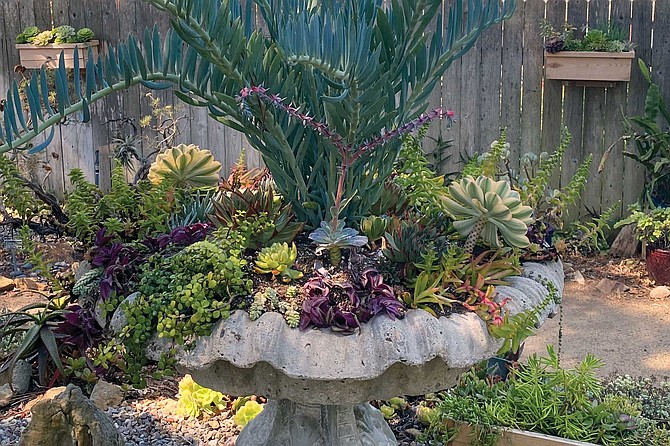 Facebook
Facebook
 X
X
 Instagram
Instagram
 TikTok
TikTok
 Youtube
Youtube

The pillars of the San Diego Botanic Garden in Encinitas are science, conservation, and education, but the things that make it wonderful to me are passion, beauty, and curation. A recent visit on a 90° day soothed me with the serene stillness of the plantings, even as San Diegans of all ages were enjoying the garden all around me. Children’s voices chirped from the treehouse in the children’s garden — or should I say gardens, because there are three, which include jungle canopies, mountain streams, and various educational interactive elements.

Educational volunteers were sprinkled about both the gardens and the conservatory. The conservatory held giant staghorn ferns and many other leafy wonders, all part of the World of Houseplants exhibit. A cheerful volunteer came up to my mother-in-law and me and answered the many questions we asked about the gorgeous variety of plants on display. (We’ve been working with succulents of late.) “People often think of succulents as being green,” said the volunteer, “but up in this garden, you’ll see some ruby red highlights, plus silver and blue.” She gave us detailed directions on how to get there via a shortcut through the walled Mexican Garden, and she also explained where to find the Undersea Succulent Garden. Still, considering the heat and the 29 gardens spread over 37 acres, I was unsure if Mom could get there. Not to worry: our volunteer led us to a shuttle stop, and after a few minutes, we were whisked up the hill past the California Gardenscapes, plus the Rainforest and New Zealand Gardens. I couldn’t help but notice the many students, volunteers and employees lovingly maintaining the different plantings. This kind of beauty takes work.
Once through the Mexican garden, we were greeted by a newly planted wire topiary of a mariachi player, complete with sombrero. Boxes full of masterfully arranged succulents hung from fences. The large green-blue tendrils of a chalk stick succulent shot forth from a concrete pedestal, mimicking a water fountain. After a half hour of marveling at land-bound succulents, we shuttled over to the Undersea Succulent Garden, which had been cleverly planted to simulate a tropical coral reef. Blazing pink, red, and orange highlights were scattered amid rocks which mimicked sea shells. The day was still hot, but the view was deliciously cool.
Besides its beauty, the San Diego Botanic Garden maintains six ongoing scientific and conservation programs, including the propagation of rare and special plants in the Otay Mountain wilderness and the protection of pollinators with economically feasible, environmentally sound ornamental horticulture. They also offer a myriad of educator and school programs, such as the upcoming Food and Flower Happy Hour Teacher’s resource fair, as well as tours, demonstration gardens, classes, and children’s activities. I will be heading back up to the garden for the cactus and succulent show and sale in early October, as well as a guided tour (these happen on a regular basis on Saturdays and Sundays, and run about three hours). Entry to the garden is ticket-based, but annual memberships start at $55 for adults.


The pillars of the San Diego Botanic Garden in Encinitas are science, conservation, and education, but the things that make it wonderful to me are passion, beauty, and curation. A recent visit on a 90° day soothed me with the serene stillness of the plantings, even as San Diegans of all ages were enjoying the garden all around me. Children’s voices chirped from the treehouse in the children’s garden — or should I say gardens, because there are three, which include jungle canopies, mountain streams, and various educational interactive elements.

Educational volunteers were sprinkled about both the gardens and the conservatory. The conservatory held giant staghorn ferns and many other leafy wonders, all part of the World of Houseplants exhibit. A cheerful volunteer came up to my mother-in-law and me and answered the many questions we asked about the gorgeous variety of plants on display. (We’ve been working with succulents of late.) “People often think of succulents as being green,” said the volunteer, “but up in this garden, you’ll see some ruby red highlights, plus silver and blue.” She gave us detailed directions on how to get there via a shortcut through the walled Mexican Garden, and she also explained where to find the Undersea Succulent Garden. Still, considering the heat and the 29 gardens spread over 37 acres, I was unsure if Mom could get there. Not to worry: our volunteer led us to a shuttle stop, and after a few minutes, we were whisked up the hill past the California Gardenscapes, plus the Rainforest and New Zealand Gardens. I couldn’t help but notice the many students, volunteers and employees lovingly maintaining the different plantings. This kind of beauty takes work.
Once through the Mexican garden, we were greeted by a newly planted wire topiary of a mariachi player, complete with sombrero. Boxes full of masterfully arranged succulents hung from fences. The large green-blue tendrils of a chalk stick succulent shot forth from a concrete pedestal, mimicking a water fountain. After a half hour of marveling at land-bound succulents, we shuttled over to the Undersea Succulent Garden, which had been cleverly planted to simulate a tropical coral reef. Blazing pink, red, and orange highlights were scattered amid rocks which mimicked sea shells. The day was still hot, but the view was deliciously cool.
Besides its beauty, the San Diego Botanic Garden maintains six ongoing scientific and conservation programs, including the propagation of rare and special plants in the Otay Mountain wilderness and the protection of pollinators with economically feasible, environmentally sound ornamental horticulture. They also offer a myriad of educator and school programs, such as the upcoming Food and Flower Happy Hour Teacher’s resource fair, as well as tours, demonstration gardens, classes, and children’s activities. I will be heading back up to the garden for the cactus and succulent show and sale in early October, as well as a guided tour (these happen on a regular basis on Saturdays and Sundays, and run about three hours). Entry to the garden is ticket-based, but annual memberships start at $55 for adults.
Comments